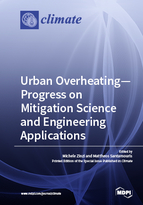Urban Overheating - Progress on Mitigation Science and Engineering Applications
A special issue of Climate (ISSN 2225-1154).
Deadline for manuscript submissions: closed (31 May 2018) | Viewed by 120091
Special Issue Editors
Interests: urban mitigation; materials for urban and built environments; energy performance of buildings
Special Issues, Collections and Topics in MDPI journals
Interests: heat island; urban mitigation; advanced materials; low energy buildings and settlements
Special Issues, Collections and Topics in MDPI journals
Special Issue Information
Dear Colleagues,
Climate change, induced by global warming, is one of the major threads of humanity, caused by humanity itself, in the present century. Long neglected or underestimated, the phenomenon, its causes, and consequences are clearly detected and have been scientifically proven. This almost unanimous consensus calls for mitigation and adaptation measures at global and local levels, in order to keep the temperature rise within 2 °C in the coming decades; physical and psychological limits above which the consequences of climate change may be not adequately governed. Another global concern is that of urban sprawl, a continuously-growing phenomenon, caused by the migration of populations from countrysides to urban areas. Populations living in cities accounted for 34% in 1960, and it grew to 54% in 2014, the growth will continue, with an average yearly rate of 1.6%, until 2030.
The combination of global warming and urban sprawl is the origin of the most hazardous climate change effect detected at urban level: The Urban Heat Island, which is defined as the increase in air temperature in a city with respect to that of the countryside’s surrounding area. The phenomenon is observed in all urban areas, even if the magnitude depends on many factors, such as environmental forcing functions, urban texture, construction materials, green and water areas, and anthropogenic heat. Urban Heat Island is spatial and time dependent; however, many studies, carried out mainly in the last two decades, have shown how urban temperatures can exceed, by more than 10 °C, those of nearby countrysides. The thermal deterioration of the urban environment has implications at several levels: Health and comfort, environment, and energy. Mitigation strategies and technologies are, thus, crucial in developing sustainable urban built environments, as well as to improve the quality of life of citizens.
In this framework, this Special Issue has the ambitious objective of publishing high quality papers, presenting the latest research and studies dedicated to mitigation solutions for urban environments. While many numerical and simulation studies are already available, this Special Issue aims at publishing innovative work, providing solutions able to improve city performances under real conditions. Relevant topics of the call are:
· Development and testing of new materials, components and systems for urban environment mitigation;
· Studies and monitoring about urban overheating and mitigation technologies and strategies in real urban conditions;
· Modeling of the urban climate for an accurate assessment of mitigation solutions;
· Development of methodologies and tools to detect, predict and mitigate the urban overheating;
· Implementation of policies and instruments to support the thermal rehabilitation of urban areas;
· Exemplary cases and demonstration projects.
Dr. Michele Zinzi
Prof. Dr. Matheos Santamouris
Guest Editors
Manuscript Submission Information
Manuscripts should be submitted online at www.mdpi.com by registering and logging in to this website. Once you are registered, click here to go to the submission form. Manuscripts can be submitted until the deadline. All submissions that pass pre-check are peer-reviewed. Accepted papers will be published continuously in the journal (as soon as accepted) and will be listed together on the special issue website. Research articles, review articles as well as short communications are invited. For planned papers, a title and short abstract (about 100 words) can be sent to the Editorial Office for announcement on this website.
Submitted manuscripts should not have been published previously, nor be under consideration for publication elsewhere (except conference proceedings papers). All manuscripts are thoroughly refereed through a single-blind peer-review process. A guide for authors and other relevant information for submission of manuscripts is available on the Instructions for Authors page. Climate is an international peer-reviewed open access monthly journal published by MDPI.
Please visit the Instructions for Authors page before submitting a manuscript. The Article Processing Charge (APC) for publication in this open access journal is 1800 CHF (Swiss Francs). Submitted papers should be well formatted and use good English. Authors may use MDPI's English editing service prior to publication or during author revisions.
Keywords
- local climate
- urban overheating
- mitigation technologies
- mitigation strategies
- urban greenery
- advanced construction materials
- impact on the built environment







